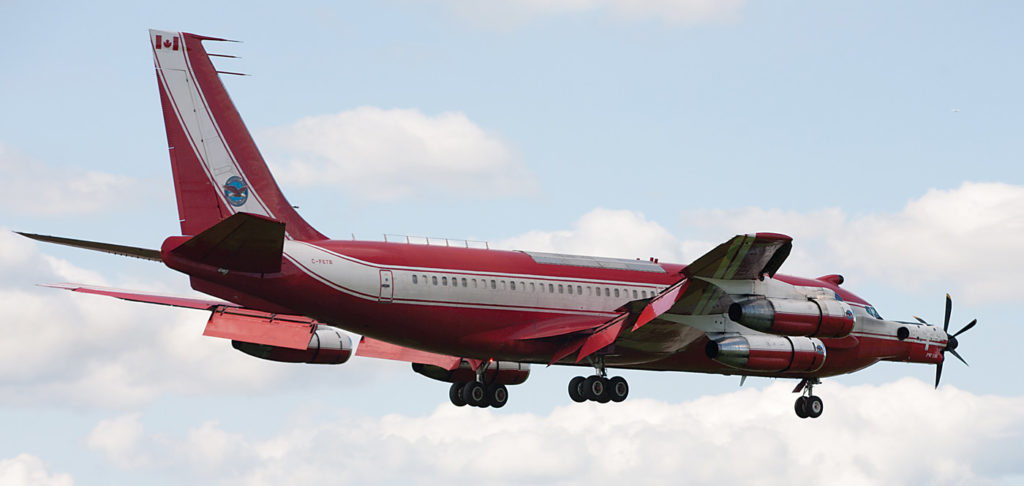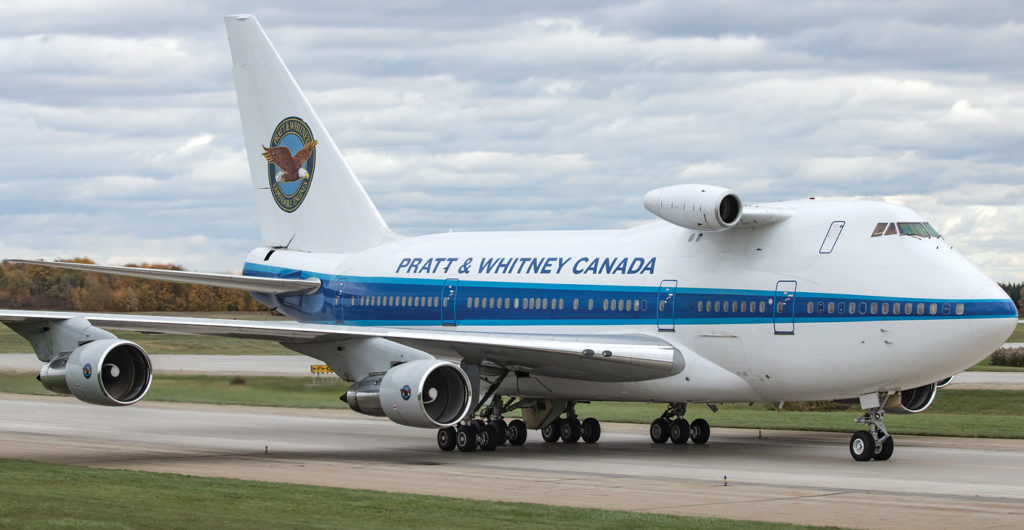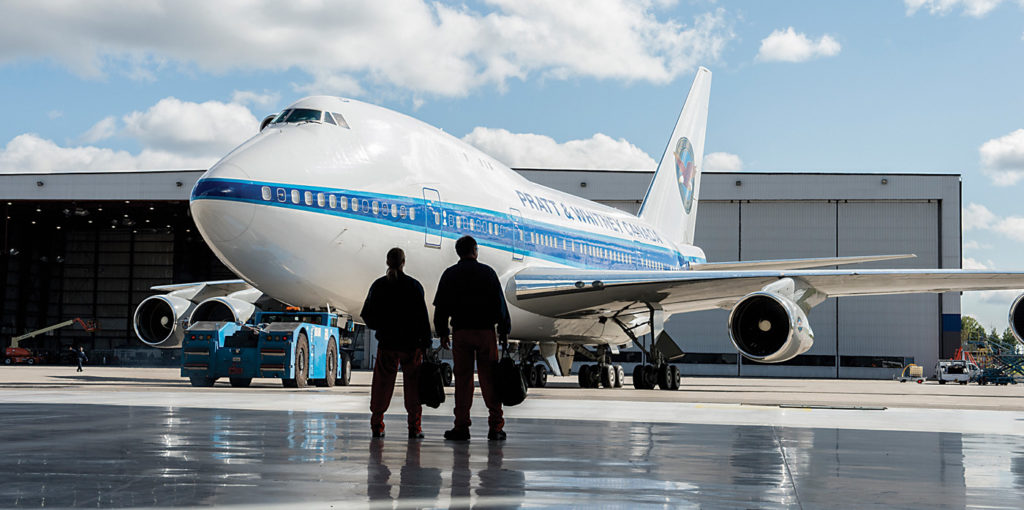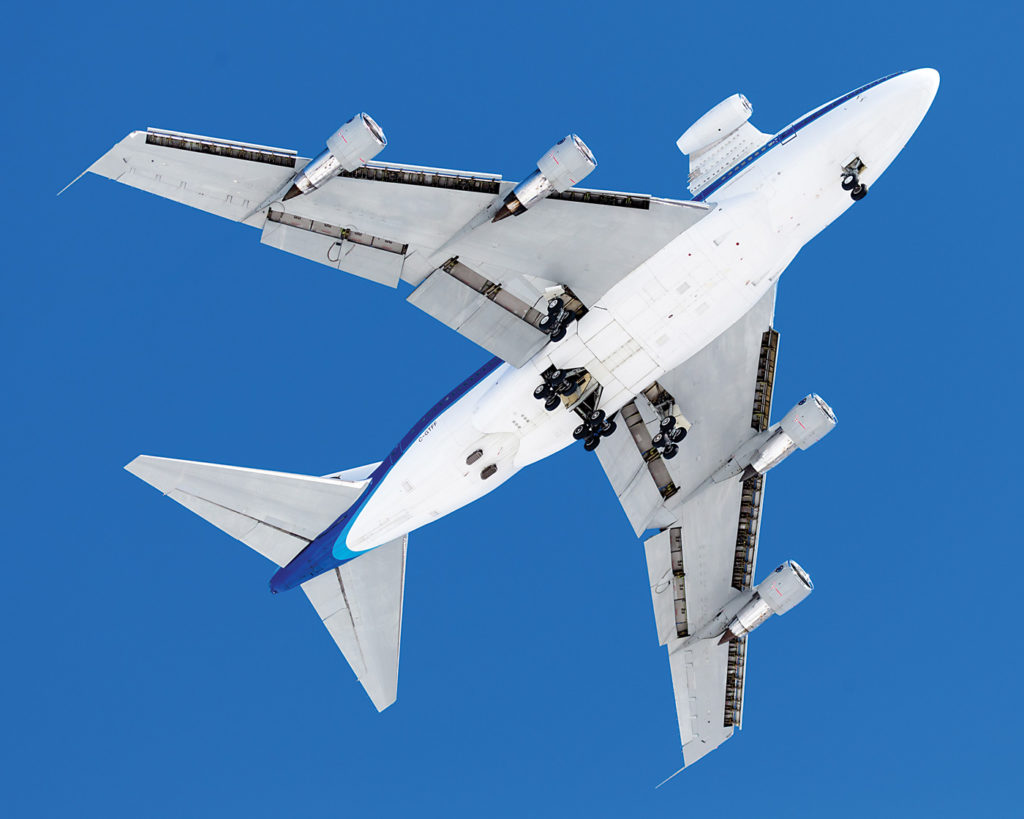Estimated reading time 11 minutes, 37 seconds.
Before a new aircraft turbine engine model can be certified and enter service, it must undergo a series of stringent tests in a ground-based test cell. In order to validate its performance metrics, the engine also has to be tested aloft.
This is achieved by attaching the prototype engine to an aircraft that has been specially modified with electronics that monitor the powerplant’s behaviour in various situations. These planes, known as flying test beds or FTBs, have included numerous types. Over the past five decades, the trend has been to use ever larger aircraft.

Flight testing has proven to be a more accurate way of assessing an engine’s operational characteristics, structural integrity and durability. The engine’s status is monitored and measured while the FTB climbs, descends, banks, accelerates and decelerates. These exercises are performed in a variety of conditions that include altitude, temperature and weather.
History
Pratt & Whitney Canada Corp. (P&WC) of Longueuil, Que., the world’s leading producer of light to medium turboprop and turbofan engines, has been utilizing FTBs for over 57 years. In 1960, P&WC borrowed a Beech 3T Expeditor from the Royal Canadian Air Force (RCAF) and converted it into a tri-motor. In addition to the two P&W Wasp Junior radials on the wings, the prototype PT6A turboprop was installed on the aircraft’s nose.
That flight test program began on May 30, 1961, and led to the certification of what has become the world’s best-selling light turboprop engine. More than 47,500 PT6As have been built to date, as well as thousands of larger derivative models.
With its first turbofan engine, the JT15D, P&WC needed an FTB that could replicate the flight envelope of the first aircraft that it would eventually be powering–the Cessna 500 Citation. The company turned again to the RCAF in November 1967 and borrowed an Avro Canada CF-100 Canuck Mk 5 jet interceptor. Because it sat high on its landing gear, the test engine could be fitted to the fuselage’s underside.
As P&WC’s product line expanded with more powerful engines, it became apparent that a larger aircraft would best accommodate the more sophisticated electronics required, as well as the heavier engines being tested. Subsequent to Air Canada retiring its fleet of Vickers Viscounts, P&WC purchased one of them in 1972 and converted it into an FTB. On May 10, 1974, it made its first test flight with the prototype PT6A-50 turboprop attached to its nose.

The Expeditor was eventually replaced with a Beech 200 Super King Air and a Gates Learjet 36 served alongside it for about 15 years.
P&WC’s flight test department entered a new era on Oct. 8, 1986, when it took delivery of a Boeing 720B quad-jet. The company had been given the responsibility of flight testing International Aero Engines’ V2500 engine. The 720B’s performance matched that of an Airbus A320, the type of aircraft that would eventually be fitted with the new engine.
It made its first flight as an FTB on May 7, 1988, with a V2500 on the number three engine’s pylon. A second 720B would later join the team and was operated by both P&W out of Plattsburgh, N.Y., and by P&WC out of Longueuil, Que.
Today’s FTBs
P&WC Flight Operations’ current fleet consists of a pair of rare Boeing 747SPs based at Mirabel, Que. “SP” stands for Special Performance, and the type has a special story.
Back in the early ’70s, Boeing decided to develop a variant of its Jumbo Jet that would have record-breaking range capability. It took the wings and P&W JT9D engines of the original 747-100 and attached them to a 48-foot-shorter fuselage.

The result was the 747SP. With its maximum payload, the SP could fly 25 per cent further than the 747-100. Airlines could now offer non-stop service between New York and Tokyo; London and Johannesburg; or Los Angeles and Sydney. Despite this exciting attribute, it struggled to find buyers and only 45 examples were built. Today, fewer than 10 are thought to be airworthy.
When asked why the 747SP was selected as an FTB, Marc Kirner, P&WC’s director of Flight Operations, explained that the aircraft’s speed, range, service ceiling and sizeable cabin made it a perfect platform for engine test missions.
“The stability of the aircraft makes it very predictable and reliable and most importantly, it has nice lines,” he said.
In order to see how the aircraft have been modified for the mission, Skies was given a tour of P&WC’s first 747SP.
The cockpits of both aircraft have been updated with Electronic Flight Instrument Systems (EFIS) and the latest navigational equipment, including a Wide Area Augmentation System (WAAS). Their cabins have been converted into airborne laboratories. The rows of passenger seats have been replaced by several rows of tall racks that contain computers and instruments that gather and analyze performance data from the test engine.
 Aft of those cabinets are three rows of work stations. Each row features a trio of arm chairs that face an array of large display screens. During a mission, these chairs are occupied by flight test engineers (FTEs) and technicians who monitor and measure the constant flow of information.
Aft of those cabinets are three rows of work stations. Each row features a trio of arm chairs that face an array of large display screens. During a mission, these chairs are occupied by flight test engineers (FTEs) and technicians who monitor and measure the constant flow of information.
Only one of these work stations has a throttle lever. The FTE in that position is in communication with the cockpit and can gain control of the test engine as required during the flight.
The first SP acquired (C-FPAW, aka FTB3) has had its number two engine pylon modified with extensive instrumentation that enables the measurement of the test engine’s performance during a mission, from start-up to shut-down.
Engines that produce up to 90,000 pounds of thrust can be hung off that pylon.
The second SP (C-GTFF aka FTB4) has a short airfoil protruding from the starboard side of the upper deck, aft of the cockpit. Engines that produce up to 20,000 pounds of thrust can be attached to the stub wing. Interestingly, that tiny airfoil not only contains the required wiring and cables for data communications, but also a fuel line that runs up from the main tanks below.

Both aircraft are certified as “Experimental” and as a result fly under flight permits.
Despite the significant modifications made for their current role, both 747SPs carry some history from their previous careers. The forward cabins in the nose of each aircraft retain the original first class seats and decorative wall coverings dating back to their days with Air China and Korean Air, respectively.
Engine flight test basics
While it typically requires 1,000 hours of ground test cell work leading to the certification of a new engine model, 150 to 200 hours of flight testing is normally needed as well.
A typical flight test mission is six to seven hours long and can be flown at altitudes up to 45,000 feet. Speeds during the flight vary, depending on what exercises are being performed on the test powerplant. For example, during a recent mission one of the 747SPs cruised at 390 knots at FL410 (41,000 feet), then later on at 520 knots at FL450 (45,000 feet).
Many of the test flights are conducted over Quebec, particularly northwest of the base at Mirabel. However, when specific conditions are required they will visit Iqaluit, Nunavut, for cold weather tests, Arizona for hot and dry conditions and Colorado for high elevation airport work.
The team
Approximately 80 individuals comprise P&WC’s Flight Operations team at Mirabel. This roster includes pilots, flight engineers, flight test engineers, instrumentation technicians, aircraft maintenance engineers and administrators.

For anyone looking to become a member of the team, the prerequisites include:
- Knowledge of engine test processes and test bed operations;
- Understanding of engine control systems used in engine test cells;
- Five years experience in engine build and testing;
- Experience in flight testing;
- Knowledge of aircraft maintenance, aircraft engines, hydraulic systems and mechanical assemblies;
- Data management skills;
- A demonstrated ability to work well within a team environment under pressure and to adapt quickly in the face of unexpected changes;
- An ability to interact effectively with a diverse group of stakeholders, including those in authority, suppliers and customers; and
- A proven ability to innovate while not being content with the status quo.
As one might imagine, the team is tightly knit and there is a culture of confidence, without arrogance. Turnover is low.
When Skies asked Kirner for characteristics that would best describe his team members, he replied they are “proud, very dynamic, highly motivated and equipped with unique skill sets.”
The future
With the continuing demand for turbine engines that are more fuel efficient, produce fewer emissions and are quieter, evolving technologies are expected to result in the creation of new engine models.
 The latest Boeing Commercial Market Outlook forecasts deliveries of 42,730 turbofan-powered airliners (including regional jets, single-aisle models, wide bodies and freighters) during the next 20 years.
The latest Boeing Commercial Market Outlook forecasts deliveries of 42,730 turbofan-powered airliners (including regional jets, single-aisle models, wide bodies and freighters) during the next 20 years.
In addition, the latest Jetcraft market forecast calls for approximately 8,700 business jets to be delivered over the next decade.
When asked what his major concern is, the group’s leader Marc Kirner replied that it is the team. Having the right people in place to do the required tasks is mandatory. He looks for candidates who “have imagination, are team players, and have a sense of wanting to have fun in a fast-paced organization.”
It takes special talents because, “We do things that people normally don’t do.”
He sees his unit as an aviation technology laboratory. Besides performing intensive research on turbine engines, it has the resources to do work on related technologies such as fuel management systems.

What about the two 747SPs? Given that their annual utilization is approximately 250 hours per aircraft, the pair should be able to perform their duties for another 20 years. Both airframes have relatively low cycles and they are in impeccable condition.
Given the expected global demand for commercial air travel and the interest in ever more efficient powerplants, it is safe to assume that the company’s product offerings will continue to grow. That should mean continued work for the “Special Performers”–the people and the planes of Pratt & Whitney Canada at Mirabel.


Quite a long history of flight testing. Looks like very interesting work with a dedicated and motivated team.